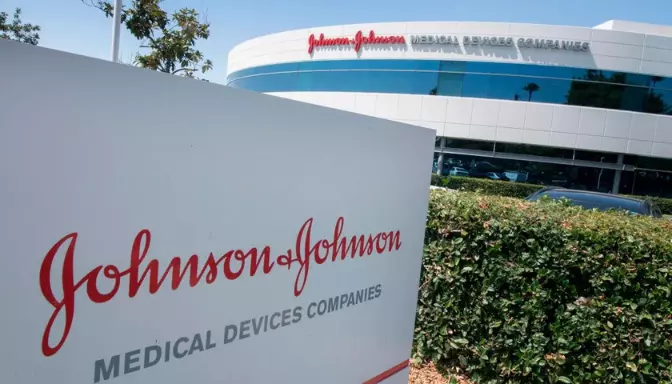Diksia.com - Johnson & Johnson (JNJ) is one of the world’s largest and most diverse healthcare companies, with operations in three segments: pharmaceutical, medical devices and diagnostics, and consumer. The company has a long history of innovation, quality, and social responsibility, and is well-known for its iconic brands such as Band-Aid, Tylenol, Neutrogena, and Listerine.
Johnson & Johnson is also a reliable dividend payer, having increased its payout for 59 consecutive years, making it a member of the prestigious Dividend Aristocrats list. The company currently offers a dividend yield of 2.96%, which is higher than the average of the S&P 500 index.
In this article, we will examine the strengths and challenges of Johnson & Johnson, and why its stock is a good investment for long-term growth and income.
Pharmaceutical Segment: A Key Growth Driver
The pharmaceutical segment is the largest and most profitable segment for Johnson & Johnson, accounting for close to 60% of its total revenue and operating income in the third quarter of 2023. The segment focuses on six therapeutic areas: immunology, oncology, neurology, pulmonary, cardiology, and metabolic diseases.
Johnson & Johnson has a strong pipeline of innovative drugs, with 14 new products launched since 2015, and 10 more expected to launch by 2025. Some of the key growth drivers in this segment include:
- Stelara, a biologic drug for the treatment of psoriasis, psoriatic arthritis, and Crohn’s disease. Stelara generated $7.6 billion in sales in 2022, up 16% year-over-year, and is expected to reach $10 billion by 2025.
- Imbruvica, an oral therapy for the treatment of various types of blood cancers. Imbruvica is co-marketed with AbbVie, and generated $4.9 billion in sales in 2022, up 9% year-over-year. The drug is expected to grow further as it expands into new indications and markets.
- Darzalex, a monoclonal antibody for the treatment of multiple myeloma, a type of blood cancer. Darzalex generated $4.2 billion in sales in 2022, up 39% year-over-year, and is expected to reach $9 billion by 2025. The drug is also being tested for other types of cancers and autoimmune diseases.
- Tremfya, a biologic drug for the treatment of moderate to severe plaque psoriasis. Tremfya generated $1.4 billion in sales in 2022, up 28% year-over-year, and is expected to reach $3 billion by 2025. The drug is also being tested for psoriatic arthritis and Crohn’s disease.
- Erleada, an oral therapy for the treatment of prostate cancer. Erleada generated $1.1 billion in sales in 2022, up 66% year-over-year, and is expected to reach $2.5 billion by 2025. The drug is also being tested for other types of cancers.
Medical Devices and Diagnostics Segment: A Recovery in Progress
The medical devices and diagnostics segment is the second-largest segment for Johnson & Johnson, accounting for about 30% of its total revenue and operating income in the third quarter of 2023. The segment focuses on four areas: orthopedics, surgery, vision care, and interventional solutions.
The segment was hit hard by the COVID-19 pandemic, as many elective and non-urgent procedures were postponed or canceled. However, the segment has shown signs of recovery, as the demand for medical devices and diagnostics has rebounded with the easing of lockdowns and the rollout of vaccines.
Some of the key growth drivers in this segment include:
- Orthopedics, which includes products for joint reconstruction, trauma, spine, sports medicine, and power tools. The orthopedics business generated $8.4 billion in sales in 2022, down 11% year-over-year, but up 62% in the third quarter of 2023 compared to the same period in 2022. The business is expected to benefit from the aging population, the rising prevalence of obesity and osteoarthritis, and the increasing adoption of robotic surgery and digital solutions.
- Surgery, which includes products for general surgery, biosurgery, endocutters, energy, and sterilization. The surgery business generated $10.3 billion in sales in 2022, down 9% year-over-year, but up 35% in the third quarter of 2023 compared to the same period in 2022. The business is expected to benefit from the growing demand for minimally invasive and advanced surgical techniques, as well as the expansion into emerging markets.
- Vision care, which includes products for contact lenses, surgical vision, and dry eye. The vision care business generated $3.6 billion in sales in 2022, down 11% year-over-year, but up 23% in the third quarter of 2023 compared to the same period in 2022. The business is expected to benefit from the increasing prevalence of myopia and presbyopia, the innovation in contact lens technology, and the growth of e-commerce and online platforms.
- Interventional solutions, which includes products for cardiovascular, neurovascular, and electrophysiology. The interventional solutions business generated $2.9 billion in sales in 2022, up 1% year-over-year, and up 19% in the third quarter of 2023 compared to the same period in 2022. The business is expected to benefit from the rising incidence of cardiovascular and neurological diseases, the advancement in device technology, and the expansion into new geographies and segments.
Consumer Segment: A Stable and Resilient Business
The consumer segment is the smallest and least profitable segment for Johnson & Johnson, accounting for about 10% of its total revenue and operating income in the third quarter of 2023. The segment focuses on five areas: baby care, beauty, oral care, over-the-counter drugs, and women’s health.
The consumer segment is a stable and resilient business, as it caters to the everyday needs of consumers around the world. The segment has a strong portfolio of trusted and well-known brands, such as Johnson’s, Neutrogena, Aveeno, Listerine, Tylenol, Zyrtec, and Motrin.
The consumer segment is also undergoing a transformation, as Johnson & Johnson announced in August 2023 that it will spin off its consumer health business into a new independent company called Kenvue. The spin-off is expected to be completed by the end of 2023, and will create two focused and agile companies with enhanced growth potential and shareholder value.
Some of the key growth drivers in this segment include:
- Baby care, which includes products for baby skin, hair, and bath care, as well as baby wipes and cotton. The baby care business generated $1.8 billion in sales in 2022, down 4% year-over-year, but up 7% in the third quarter of 2023 compared to the same period in 2022. The business is expected to benefit from the innovation in natural and gentle products, the expansion into new markets and channels, and the improvement in birth rates after the pandemic.
- Beauty, which includes products for skin health, hair care, and cosmetics. The beauty business generated $4.8 billion in sales in 2022, down 7% year-over-year, but up 13% in the third quarter of 2023 compared to the same period in 2022. The business is expected to benefit from the recovery in consumer spending and confidence, the growth of e-commerce and online platforms, and the diversification of product offerings and consumer segments.
- Oral care, which includes products for oral hygiene, whitening, and fresh breath. The oral care business generated $1.7 billion in sales in 2022, up 3% year-over-year, and up 9% in the third quarter of 2023 compared to the same period in 2022. The business is expected to benefit from the increasing awareness and demand for oral health, the innovation in product technology and design, and the expansion into new markets and categories.
- Over-the-counter drugs, which includes products for pain relief, allergy, cold and flu, digestive health, and smoking cessation. The over-the-counter drugs business generated $5.4 billion in sales in 2022, up 4% year-over-year, and up 8% in the third quarter of 2023 compared to the same period in 2022. The business is expected to benefit from the growing consumer preference for self-care and wellness, the strong brand equity and loyalty, and the introduction of new products and formats.
- Women’s health, which includes products for feminine hygiene, intimate care, and menopause. The women’s health business generated $1.3 billion in sales in 2022, down 3% year-over-year, but up 6% in the third quarter of 2023 compared to the same period in 2022. The business is expected to benefit from the increasing demand and awareness for women’s health, the innovation in product quality and safety, and the growth of e-commerce and online platforms.
COVID-19 Vaccine: A Potential Game Changer
In addition to its core businesses, Johnson & Johnson is also involved in the development and distribution of a COVID-19 vaccine, which could be a potential game changer for the company and the world. The vaccine, developed in collaboration with Janssen Pharmaceuticals and Beth Israel Deaconess Medical Center, is based on a viral vector platform that uses a modified version of a common cold virus to deliver genetic material that instructs the body to produce antibodies against the coronavirus.
The vaccine has several advantages over other COVID-19 vaccines, such as:
- Single dose: The vaccine requires only one shot, unlike most other vaccines that require two doses, which simplifies the logistics and increases the accessibility of the vaccine.
- Refrigeration: The vaccine can be stored at normal refrigerator temperatures for up to three months, unlike some other vaccines that require ultra-cold storage, which reduces the cost and complexity of the distribution chain.
- Efficacy: The vaccine has shown to be 66% effective in preventing moderate to severe COVID-19, and 85% effective in preventing severe COVID-19, across all regions and variants. The vaccine has also shown to provide complete protection against COVID-19 related hospitalization and death.
- Safety: The vaccine has a favorable safety profile, with no serious adverse events reported, and no cases of severe allergic reactions or blood clots.
Johnson & Johnson has received emergency use authorization from the U.S. Food and Drug Administration, the European Medicines Agency, and the World Health Organization for its COVID-19 vaccine. The company has also signed agreements with various governments and organizations to supply up to 1.2 billion doses of its vaccine in 2023. The company expects to generate $2.5 billion in revenue from its COVID-19 vaccine in 2023, which will be donated to non-profit organizations for pandemic relief efforts.
Financial Performance: A Solid Track Record
Johnson & Johnson has a solid track record of financial performance, as it has delivered consistent growth in revenue, earnings, and cash flow over the years. The company has also maintained a strong balance sheet, with a low debt-to-equity ratio of 0.46, and a high interest coverage ratio of 20.6, as of September 30, 2023. The company has also generated a high return on equity of 25.4%, and a high return on invested capital of 17.4%, as of September 30, 2023.
The company has also demonstrated its resilience and adaptability in the face of the COVID-19 pandemic, as it managed to grow its revenue by 0.6% to $82.6 billion, and its adjusted earnings per share by 3.8% to $8.38, in 2022, despite the negative impact of the pandemic on its medical devices and consumer segments. The company has also raised its guidance for 2023, as it expects to grow its revenue by 10.5% to $91.5 billion, and its adjusted earnings per share by 18.4% to $9.92, in 2023, driven by the recovery of its core businesses and the contribution of its COVID-19 vaccine.
Valuation: A Reasonable Price for a Quality Stock
Johnson & Johnson is currently trading at $173.45 per share, as of January 7, 2024, which implies a trailing price-to-earnings ratio of 20.7, and a forward price-to-earnings ratio of 17.5. These multiples are lower than the average of the S&P 500 index, which has a trailing price-to-earnings ratio of 28.9, and a forward price-to-earnings ratio of 22.4.
Johnson & Johnson also offers a dividend yield of 2.96%, which is higher than the average of the S&P 500 index, which has a dividend yield of 1.34%. The company has a payout ratio of 61.3%, which indicates that it has enough room to sustain and grow its dividend in the future.
Based on these metrics, Johnson & Johnson appears to be undervalued compared to the market, and offers a reasonable price for a quality stock.
Conclusion
Johnson & Johnson is a leading healthcare company with a diversified portfolio of products and services, spanning across pharmaceutical, medical devices and diagnostics, and consumer segments. The company has a long history of innovation, quality, and social responsibility, and is well-known for its iconic brands.
Johnson & Johnson is also a reliable dividend payer, having increased its payout for 59 consecutive years, making it a member of the prestigious Dividend Aristocrats list. The company currently offers a dividend yield of 2.96%, which is higher than the average of the S&P 500 index.
Johnson & Johnson has a strong pipeline of innovative drugs, with 14 new products launched since 2015, and 10 more expected to launch by 2025. The company also has a potential game changer in its COVID-19 vaccine, which has several advantages over other vaccines, such as single dose, refrigeration, efficacy, and safety. The company expects to generate $2.5 billion in revenue from its COVID-19 vaccine in 2023, which will be donated to non-profit organizations for pandemic relief efforts.
Johnson & Johnson has a solid track record of financial performance, as it has delivered consistent growth in revenue, earnings, and cash flow over the years. The company has also maintained a strong balance sheet, with a low debt-to-equity ratio, and a high interest coverage ratio. The company has also generated a high return on equity, and a high return on invested capital.
Johnson & Johnson is currently trading at a reasonable price for a quality stock, as it has a lower price-to-earnings ratio, and a higher dividend yield, than the average of the S&P 500 index. The company also has a low payout ratio, which indicates that it has enough room to sustain and grow its dividend in the future.
Johnson & Johnson is a healthcare giant with a bright future, and a good investment for long-term growth and income.






